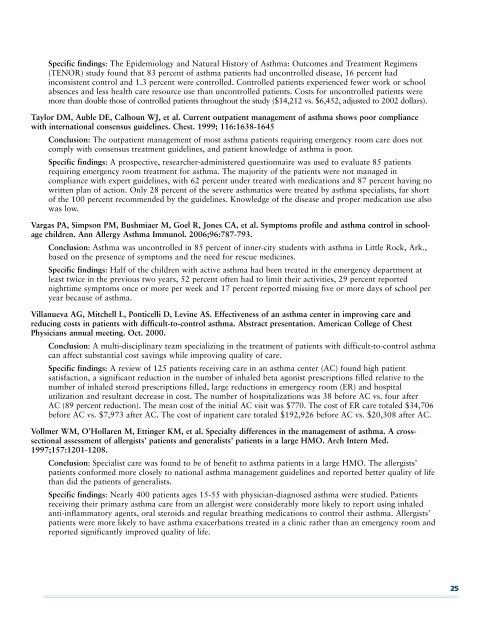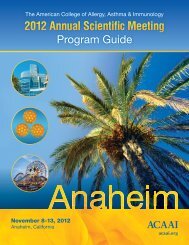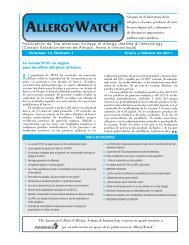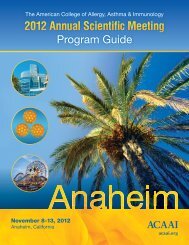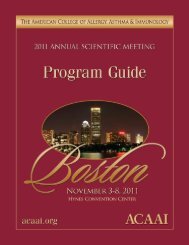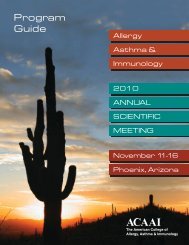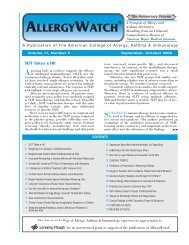Better Outcomes at Lower Cost - American College of Allergy ...
Better Outcomes at Lower Cost - American College of Allergy ...
Better Outcomes at Lower Cost - American College of Allergy ...
- No tags were found...
Create successful ePaper yourself
Turn your PDF publications into a flip-book with our unique Google optimized e-Paper software.
Specific findings: The Epidemiology and N<strong>at</strong>ural History <strong>of</strong> Asthma: <strong>Outcomes</strong> and Tre<strong>at</strong>ment Regimens(TENOR) study found th<strong>at</strong> 83 percent <strong>of</strong> asthma p<strong>at</strong>ients had uncontrolled disease, 16 percent hadinconsistent control and 1.3 percent were controlled. Controlled p<strong>at</strong>ients experienced fewer work or schoolabsences and less health care resource use than uncontrolled p<strong>at</strong>ients. <strong>Cost</strong>s for uncontrolled p<strong>at</strong>ients weremore than double those <strong>of</strong> controlled p<strong>at</strong>ients throughout the study ($14,212 vs. $6,452, adjusted to 2002 dollars).Taylor DM, Auble DE, Calhoun WJ, et al. Current outp<strong>at</strong>ient management <strong>of</strong> asthma shows poor compliancewith intern<strong>at</strong>ional consensus guidelines. Chest. 1999; 116:1638-1645Conclusion: The outp<strong>at</strong>ient management <strong>of</strong> most asthma p<strong>at</strong>ients requiring emergency room care does notcomply with consensus tre<strong>at</strong>ment guidelines, and p<strong>at</strong>ient knowledge <strong>of</strong> asthma is poor.Specific findings: A prospective, researcher-administered questionnaire was used to evalu<strong>at</strong>e 85 p<strong>at</strong>ientsrequiring emergency room tre<strong>at</strong>ment for asthma. The majority <strong>of</strong> the p<strong>at</strong>ients were not managed incompliance with expert guidelines, with 62 percent under tre<strong>at</strong>ed with medic<strong>at</strong>ions and 87 percent having nowritten plan <strong>of</strong> action. Only 28 percent <strong>of</strong> the severe asthm<strong>at</strong>ics were tre<strong>at</strong>ed by asthma specialists, far short<strong>of</strong> the 100 percent recommended by the guidelines. Knowledge <strong>of</strong> the disease and proper medic<strong>at</strong>ion use alsowas low.Vargas PA, Simpson PM, Bushmiaer M, Goel R, Jones CA, et al. Symptoms pr<strong>of</strong>ile and asthma control in schoolagechildren. Ann <strong>Allergy</strong> Asthma Immunol. 2006;96:787-793.Conclusion: Asthma was uncontrolled in 85 percent <strong>of</strong> inner-city students with asthma in Little Rock, Ark.,based on the presence <strong>of</strong> symptoms and the need for rescue medicines.Specific findings: Half <strong>of</strong> the children with active asthma had been tre<strong>at</strong>ed in the emergency department <strong>at</strong>least twice in the previous two years, 52 percent <strong>of</strong>ten had to limit their activities, 29 percent reportednighttime symptoms once or more per week and 17 percent reported missing five or more days <strong>of</strong> school peryear because <strong>of</strong> asthma.Villanueva AG, Mitchell L, Ponticelli D, Levine AS. Effectiveness <strong>of</strong> an asthma center in improving care andreducing costs in p<strong>at</strong>ients with difficult-to-control asthma. Abstract present<strong>at</strong>ion. <strong>American</strong> <strong>College</strong> <strong>of</strong> ChestPhysicians annual meeting. Oct. 2000.Conclusion: A multi-disciplinary team specializing in the tre<strong>at</strong>ment <strong>of</strong> p<strong>at</strong>ients with difficult-to-control asthmacan affect substantial cost savings while improving quality <strong>of</strong> care.Specific findings: A review <strong>of</strong> 125 p<strong>at</strong>ients receiving care in an asthma center (AC) found high p<strong>at</strong>ients<strong>at</strong>isfaction, a significant reduction in the number <strong>of</strong> inhaled beta agonist prescriptions filled rel<strong>at</strong>ive to thenumber <strong>of</strong> inhaled steroid prescriptions filled, large reductions in emergency room (ER) and hospitalutiliz<strong>at</strong>ion and resultant decrease in cost. The number <strong>of</strong> hospitaliz<strong>at</strong>ions was 38 before AC vs. four afterAC (89 percent reduction). The mean cost <strong>of</strong> the initial AC visit was $770. The cost <strong>of</strong> ER care totaled $34,706before AC vs. $7,973 after AC. The cost <strong>of</strong> inp<strong>at</strong>ient care totaled $192,926 before AC vs. $20,308 after AC.Vollmer WM, O’Hollaren M, Ettinger KM, et al. Specialty differences in the management <strong>of</strong> asthma. A crosssectionalassessment <strong>of</strong> allergists’ p<strong>at</strong>ients and generalists’ p<strong>at</strong>ients in a large HMO. Arch Intern Med.1997;157:1201-1208.Conclusion: Specialist care was found to be <strong>of</strong> benefit to asthma p<strong>at</strong>ients in a large HMO. The allergists’p<strong>at</strong>ients conformed more closely to n<strong>at</strong>ional asthma management guidelines and reported better quality <strong>of</strong> lifethan did the p<strong>at</strong>ients <strong>of</strong> generalists.Specific findings: Nearly 400 p<strong>at</strong>ients ages 15-55 with physician-diagnosed asthma were studied. P<strong>at</strong>ientsreceiving their primary asthma care from an allergist were considerably more likely to report using inhaledanti-inflamm<strong>at</strong>ory agents, oral steroids and regular bre<strong>at</strong>hing medic<strong>at</strong>ions to control their asthma. Allergists’p<strong>at</strong>ients were more likely to have asthma exacerb<strong>at</strong>ions tre<strong>at</strong>ed in a clinic r<strong>at</strong>her than an emergency room andreported significantly improved quality <strong>of</strong> life.25


